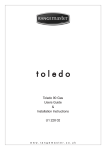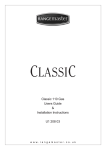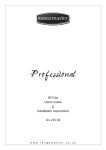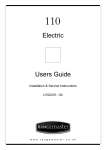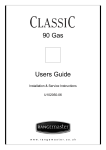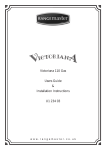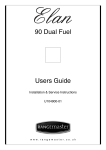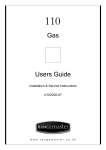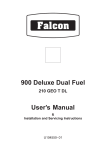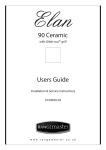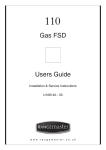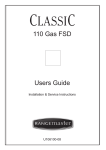Download Rangemaster 110 Range User Manual
Transcript
Toledo 110 Dual Fuel Users Guide & Installation Instructions U1 229 02 Contents 2 Minute Tour Page 3 The Hotplate burners Page 8 The Griddle Page 8 The Warmer Page 8 The Grill Page 8 The Ovens Page 9 Oven shelves Page 9 The Handyrack Page 10 The Browning Element Page 10 Cooking using the timer Page 10 The clock Page 11 Moving your cooker Page 12 Oven cooking guide Page 13 Cleaning your cooker Page 14 Troubleshooting Page 17 General Safety Instructions Page 19 Installation Page 21 Circuit Diagram Page 29 Technical Data Page 30 2 2 Minute Tour Be safe You need clean fresh air - so does your cooker. Burner flames produce exhaust gases, heat and moisture. Make sure that the kitchen is well ventilated: keep natural ventilation holes open or install a powered cooker hood that vents outside. If you have several burners on or use the cooker for a long time, open a window or turn on an extractor fan. For more detail see the Installation Instructions. If you have not used a gas cooker before, we recommend you read pages 19-20 where we describe some basic guidelines on how to use a gas cooker safely. Gas and Electricity on Make sure that the gas supply is turned on and that the cooker is wired in and switched on. The cooker needs electricity. Peculiar smells When you first use your cooker it may give off a slight odour. This should stop after a little use. HOTPLATE BURNERS More about the burners on page 8 The drawing by each knob indicates which burner that knob controls. Push in and turn a knob to the large flame symbol ( ) and press the igniter button or light with a match. 1 Simmering aids, such as or mesh mats, are 4 asbestos NOT recommended. They will reduce burner performance and could damage the pan supports. Adjust the flame height to suit by turning the knob. On this cooker the low position is beyond high, not between high and off. The small flame marks the ‘low position’. Turn the knob towards it after the contents of a pan have boiled. 2 using unstable and 5 Avoid misshapen pans that may tilt easily and pans with a very small base diameter e.g. milk pans, single egg poachers. The minimum pan diameter recommended is 120mm (about 43/4"). Make sure flames are under the Using a lid will help the 3 pans. contents boil more quickly. Pans and kettles with concave bases or down turned base rims should not be used. The Wok burner is designed to provide even heat over a large area. It is ideal for large pans and stir frying. For heating smaller pans the smaller burners may be more efficient. 6 2 Minute Tour continues over the page... 3 2 Minute Tour - continued GRIDDLE More about the griddle on page 8 The griddle fits a single pan support, front to back. It is designed for cooking food on directly. Don’t use pans of any kind on it. The griddle surface is non-stick and metal cooking utensils (e.g. spatulas) will damage the surface. Use heat resistant plastic or wooden utensils. 1 Preheat the griddle for a Don’t put it crossways - it will Position the griddle over the fit properly and will be 2 not unstable. burners resting on the 3 hotplate pan support. The griddle can be Don’t put it on the Wok burner - it is not designed to fit the Wok burner pan support. lightly brushed with cooking oil before use. Light the hotplate burners. Adjust the flame heights to suit. Always leave space around the of 5 minutes before 4 maximum adding food. Leaving it longer for the gases to escape. 5 griddle Never fit two griddles side by may cause damage. The controls can be turned to a lower position simply by turning the control knobs towards the lower position marked with the small flame symbol. side. Large pans should also be spaced well apart. 4 GRILL More about the grill on page 8 CAUTION: Accessible parts may be hot when the grill is in use. Young children should be kept away. Remove the pan from the After placing your food on the tray pan, slide the grill pan 1 bottom of the grill compartment. 2 grill onto the side supports just below the elements. Make sure it is pushed right in and touches the backstop. For best results preheat for 2 The grill has two elements that either the whole area of 3 allow the pan to be heated or only the right hand half of the grill pan to be heated. Turn the knob to position 3. The grill pan grid can be turned with the grill pan in to give two grilling 5 over 4 minutes position. After placing your food positions. on the grill pan grid, slide the grill pan onto the side supports. Adjust the heat to suit by turning the knob. Make sure it is pushed right in and touches the back stop. Never close the grill door when the grill is on. 2 Minute Tour continues over the page... 5 2 Minute Tour - continued OVEN More about the oven on page 9 Turn the oven knob to the 1 temperature you need. THE LEFT HAND The oven indicator light will glow When cooking foods with high then cycle on and off during cooking. visible at the grille at the rear of the hotplate. This is perfectly normal. the oven has reached the content (e.g. oven chips) 2 until 3 water temperature you selected. It will there may be some steam OVEN THE RIGHT The left hand conventional oven HAND FAN OVEN The fan in the right hand oven hot air continuously fitted with two heating 5 circulates 4 iselements, which means faster more even one visible in the top of the oven and the second under the oven base. Be careful to avoid touching the top element and element deflector when placing or removing items from the oven. cooking. The recommended cooking temperatures for a fanned oven are generally lower than a non-fanned oven. The fan only setting. The fan 6 circulates air inside the oven but the heating element is not turned on. This setting is useful for defrosting frozen foods. Whole chickens and large joints of meat should be defrosted in the refrigerator. Do not defrost in a warm oven or whilst the adjoining oven is hot. To set the time of day More about the clock on page 11 can use the timer to turn 7 You the oven on and off. Check clock is set to time of day. Press and hold as above. At the same time, press (-) or (+) until the correct time shows. Don’t forget it’s a 24 hour clock. If you make a mistake or press the wrong button, turn off the power supply for a minute or two and start again. 6 Warmer Handyrack Oven light More about the Handyrack on page 10. Use the warmer for keeping food warm while the final touches are put to a meal. Turn the control knob anticlockwise to the ‘On’ position. The ‘HOT’ indicator lights up. For best results, pre-heat a covered serving dish for 10 minutes before adding food to it. Storage The Handyrack fits on the oven door. Food cooking on it is easy to attend to, because it’s accessible when the door is open. It can be fitted at two different heights. One of the oven shelves must be removed and the other positioned to suit. To fit the Handyrack, locate one side of it on the door bracket. Press the appropriate button to turn on one of the oven lights. If one of the oven lights fail, turn off the power supply before you change the bulb. See the ‘Troubleshooting’ section for details on how to change an oven light bulb. Then spring the other side out to clip it onto the other bracket. The bottom drawer is for storing oven trays and other cooking utensils. It can get very warm, don’t store anything in it which may melt or catch fire. The drawer can be removed completely by pulling it right out and up. PARTS CHECK You should have these loose parts with your cooker Meat tin Handyrack. The Handyrack is explained later in the 2 Minute Tour. It may have been left fitted. It is easily removable. 7 The Hotplate burners The Warmer You should read ‘hotplate burners’ in the ‘2 Minute Tour’ before all the following information The Warmer can be used for keeping food warm while the final touches are put to a meal. For best results preheat a covered serving dish for 10 minutes on the Warmer before adding the food. When the spark button (IGN) is pressed, sparks will be made at every burner, this is normal. Turn the control knob clockwise to the 'On' position. The 'HOT' indication light glows on the Warmer. If after lighting, a hotplate burner’s flame goes out, turn it off and leave it for one minute before relighting it. CAUTION:- If a crack in the Warmer surface becomes visible, due to accidental damage etc., isolate the appliance from the electricity supply immediately by turning it off at the wall and arrange for its repair. You can remove the burner cap and trim rings for cleaning, see pages 14/15. You should wipe the enamel top surface of the cooker around the hotplate burners as soon as possible after spills occur. Try to wipe them off while the enamel is still warm. DO NOT RECONNECT THE COOKER TO THE ELECTRICITY SUPPLY UNTIL AFTER REPAIR! Avoid using unstable and misshapen pans which may tilt easily and pans with a very small base diameter, e.g. milk pans, single egg poachers. The minimum pan diameter recommended is 120mm (43/4"). Smaller pans will be unstable. The Grill You should read ‘grill’ in the ‘2 Minute Tour’ before all the following information. Pans and kettles with down turned base rims should not be used. Never close the grill door while the grill is on. Don’t leave the grill on for more than a few moments, without the grill pan underneath it. The Griddle You should read ‘griddle’ in the ‘2 Minute Tour’ before all the following information For best results, especially with toast, preheat the grill with the grill pan in the cooking position for two minutes before use. Use the following heat settings as a guide for griddle cooking. High/medium: Drop scones, Bacon, Chops, Steak, Burgers. Medium/low: Potato cakes, Eggs, Fish cakes. The grill trivet can be removed and the food placed on it while you are waiting for the grill to preheat. The grill pan grid can be turned over to give two grilling positions. Experience will soon familiarise you with the correct setting to use for cooking. After cooking allow the griddle to cool before cleaning. Don’t put it on the Wok burner - it is not designed to fit the Wok burner pan support. 8 The Ovens You should read ‘the ovens’ in the ‘2 Minute Tour’ before all the following information. • To reduce fat splashing when you add vegetables to hot fat around a roast, dry them thoroughly or brush lightly with cooking oil. • Sufficient heat rises out of the oven while cooking to warm plates in the grill compartment. • If you want to brown the base of a pastry dish, preheat the baking tray for 15 minutes before placing the dish in the centre of the tray. • Where dishes may boil and spill over during cooking, place them on a baking tray. The two ovens in your cooker are of different types. • The right hand oven is a fanned oven. The fan circulates hot air continuously which results in faster heat transfer to the food. • The left hand conventional oven is fitted with two heating elements, one visible in the top of the oven and the second under the oven base. Take care to avoid touching the top element and element deflector when placing or removing items from the oven. Before using for the first time, heat the ovens to 200°C for 30 minutes to dispel manufacturing odours. Oven shelves The oven shelves can be easily removed and refitted. The wire shelves should always be pushed firmly to the back of the oven. Baking trays meat tins etcetera should be placed level centrally on the oven’s wire shelves. Keep all trays and containers away from the sides of the oven, as overbrowning of the food may occur. For even browning, the maximum recommended size of a baking tray is 325mm by 305mm. Cooking high moisture content foods can create a ‘steam burst’, when the oven door is opened. When opening the oven stand well back and allow any steam to disperse. the shelf guard should be at the back pointing upwards When the oven is on, don’t leave the door open for longer than necessary, otherwise the knobs may get very hot. • Always leave a ‘fingers width’ between dishes on the same shelf. This allows the heat to circulate freely around them. • The Cook & Clean oven liners (see Cleaning your cooker) work better when fat splashes are avoided. Cover meat when cooking. To refit the shelf, line up the shelf with a groove in the oven side and push the shelf back until the ends hit the shelf stop. Lift up the front so the 9 shelf ends clear the shelf stops, and then lower the front so that the shelf is level and push it fully back. Cooking using the timer The Handyrack The timer can be used to turn just one oven or both on and off automatically. The start and stop time must be the same for both ovens but different cooking temperatures can be set. If you want to turn one of the ovens on at the same time as the timer is set for automatic cooking, you must wait until the timer has turned on the oven/ ovens first. Then you can adjust either of them manually in the normal way. You can set the oven to turn on any time over the following 24 hour period You should read ‘the oven’ in the ‘2 Minute Tour’ before all the following information If you want to cook more than one dish, choose dishes that require approximately the same time. However, dishes can be ‘slowed down’ slightly by using small containers and covering them with aluminium foil, or ‘speeded up’ slightly by cooking smaller quantities or placing in larger containers. The maximum weight which can be held by the Handyrack is 5.5kg (12lb). When the Handyrack is used in its highest position, other dishes can be cooked on the bottom shelf position of the oven. When the Handyrack is used in its lowest position, other dishes can be cooked on the second shelf position of the oven or standing on the base of the oven. Very perishable foods such as pork or fish should be avoided if a long delay period is planned, especially in hot weather. Don’t place warm food in the oven. Don’t use an oven already warm. Don’t use if an adjoining oven is warm. The roasting tray supplied with the oven fits into the Handyrack. Avoid using wine or beer if there is a delay period, as fermentation may take place. The Browning Element To avoid curdling, cream should be added to dishes just before serving. The Browning Element is positioned in the top of the left hand oven. It can be used at the end of a normal cooking period to give extra browning to au gratin dishes or give a crisper finish to meat. Fresh vegetables, which may discolour during a delay period, should be coated in melted fat or immersed in a water and lemon juice solution. After the normal cooking is finished turn the left hand oven thermostat knob clockwise to the browning position, indicated by ( ) on the facia panel. Only the browning element will operate when the thermostat is turned to this position. The top and base cooking elements will automatically switch off. Fruit pies, custard tarts or similar wet mixtures on top of uncooked pastry are only satisfactory if there is a short delay period. Dishes containing leftover cooked meat or poultry should not be cooked automatically if there is a delay period. Whole poultry must be thoroughly defrosted before placing in the oven. Check that meat and poultry are fully cooked before serving. 10 The clock To set the correct time of day. To start and stop the oven automatically See the ‘2 Minute Tour’ at the beginning of this guide. Before you set the clock, you must have two numbers clearly in mind. The ‘cook period’, which is the period of time you want the oven to cook. The ‘stop time’, which is the time of day you want the oven to stop cooking. You cannot set a start time directly - this is set automatically by setting the cooking period and stop time. To time something that’s cooking (minute minder) Press and hold as above. At the same time press (-) or (+) until the time you want to cook for is shown, as below. Press and hold as above. At the same time press (-) or (+) until your required ‘cook period’ shows. You can check time remaining by pressing and cancel the beeper by pressing Then press and hold as above. At the same time press (-) or (+) until your required ‘stop time’ shows. AUTO will show in the display. Set the oven to the required temperature. When your cooking is finished the beeper sounds. TURN THE OVEN KNOB TO 0 FIRST, then press once to stop the beep, press again to return to manual cooking. If you are out, don’t worry about the beeper going off, it stops after a while. When you return, TURN THE OVEN KNOB TO 0 FIRST, then press twice, to return to manual cooking. To stop automatically Use when you have started the oven manually. Press and hold as above. At the same time press (-) or (+) until your required ‘Stop Time’ shows. AUTO will show in the display. When your cooking is finished the beeper sounds. TURN THE OVEN KNOB TO 0 FIRST, then press once to stop the beep, press again to return to manual cooking. AUTO is showing, you want to reset to manual cooking. When cancelling an automatic setting, any cooking time already set must be returned to 0.00 before you can return to manual, by pressing the button. 11 The oven control settings and cooking times given opposite are intended to be used only as a guide. Individual tastes may require the temperature to be altered to provide a preferred result. Food is cooked at lower temperature in a fan oven than in a conventional oven. When using recipes, reduce the temperature by 10°C and the cooking time by 5-10 minutes. The temperature in the fanned oven does not vary with height in the oven - so you can use any shelf. Always leave at least one runner space between shelves when 2 tier cooking. Place baking trays, individual cake tins or baking dishes centrally on the oven shelf. For best results pre-heat the oven until the oven indicator light goes out. Moving your cooker Switch off the electricity supply. Turn the levelling tool clockwise, two full (180°) turns. It will be stiff. The front of the oven will rise slightly as the roller drops down. The cooker is heavy; two people may be required to move it. The cooker is fitted with one roller at the front and two at the back. There are also two screw down levelling feet at the front. The front roller, designed for moving the cooker can be wound down. The levelling tool which controls this roller is in the storage drawer compartment. Remove the storage drawer (by pulling it right out and lifting it up slightly) and you should see the levelling tool. Open the grill door and right hand oven door so that you can get a good grip on the bottom of the fascia panel as you move the oven. Do not move the oven by pulling the hand rail, door handles or knobs. Move the oven a bit at a time, checking behind it to make sure the gas hose is not caught. Make sure both electricity and gas cables have sufficient slack to move the cooker forward as you go along. Your installer may not have left the levelling tool in place. If not, locate it as shown. If you cannot find the levelling tool, contact your installer. See the front of the Installation section of these instructions. If a stability chain is fitted, release it as you ease the cooker out. When you replace the cooker, wind it down off the rollers by turning the levelling tool anticlockwise. This is important. It will stop the cooker moving accidentally, while in use. 12 Oven cooking guide LH Convection Oven Shelf Temp Position Food RH Fan Oven Temp Approximate Cooking Time FISH 190°C 190°C 190°C 3 3 3 180°C 180°C 180°C Fillets 15-20mins. Whole 10mins.per 500g + 10mins. Steaks according to thickness. ROAST MEATS Beef with bone 160°C 2-3 150°C 20-25mins. per 500g + 20-25mins. 200°C 2-3 190°C 15-20mins. per 500g + 15-20mins. Beef without bone 160°C 2-3 150°C 30-35mins. per 500g + 30-35mins. 200°C 2-3 190°C 20-25mins. per 500g + 20-25mins. Lamb 170°C 2-3 160°C 30-35mins. per 500g + 30-35mins. 200°C 2-3 190°C 25-35mins. per 500g + 25-30mins. Pork 160°C 2-3 150°C 35-40mins. per 500g + 35-40mins. 200°C 2-3 190°C 25-30mins. per 500g + 25-30mins. Stuffed and rolled - Add approx. 10 mins. per 500g to above cooking times or cook at 200°C for 20mins. then 160°C for remainder. THOROUGHLY THAW FROZEN JOINTS AND POULTRY BEFORE COOKING. POULTRY Chicken 160°C 2-3 150°C 20-25mins. per 500g + 20-25mins. 200°C 2-3 190°C 15-20mins. per 500g + 15-20mins. Turkey 160°C 1-3 150°C 20-25mins. per 500g + 20-25mins. 200°C 1-3 190°C 15-20mins. per 500g + 15-20mins. Stuffed Poultry - Cook at 200°C or at 200°C for 20mins. then 160°C for remainder. Prepacked (fresh or frozen) follow packers cooking times THOROUGHLY THAW FROZEN POULTRY BEFORE COOKING CASSEROLE YORKSHIRE PUDDING 140-150°C 220°C 2-3 4 140°C 200°C 2-4hrs according to recipe. Large tin 30-35mins. Individual 10-20mins. 140°C 150°C 160°C 190°C 220°C 180°C 2 2 2 3 & 5 or 3 2 & 4 or 3 2 & 4 or 3 140°C 145°C 150°C 180°C 210°C 170°C 45-50mins. per 500g mixture 21/2-3hrs. 80-90mins. 15-25mins. 10-15mins. 20-30mins. 200°C 200°C 200°C 220°C 220°C 110°C 2&4 2&4 4 2,3 or 4 2&4 3 190°C 190°C 190°C 200°C 200°C 100°C 45-50mins. Interchange after 25mins. 35-40mins. 15-20mins. according to size. 20-40mins. according to size. 20-30mins. 2-21/2hrs 160°C 190°C 150°C 3 3 3 150°C 180°C 150°C 45mins.-1hr. 40-45mins. 2-3hrs. CAKES Very Rich Fruit Rich fruit (180mm) Madeira (180mm) Queen Cakes Scones Victoria Sandwich PASTRIES Plate Tart Fruit Pie Tartlets Puff Pastry BREAD MERINGUES PUDDINGS Baked Egg Custard Baked sponge pudding Milk pudding 500g is approximately 1lb (1lb 2oz) 13 Cleaning your cooker Hotplate burners Some models have a separate trim ring, which fits on the burner head. Essential information Before thorough cleaning isolate the electricity supply. Remember to switch on the electricity supply before use. Never use paint solvents, washing soda, caustic cleaners, biological powders, bleach, chlorine based bleach cleaners, coarse abrasives or salt. Don’t mix different cleaning products - they may react together with hazardous results. Recommended cleaning materials are shown in the chart below. The burner heads and caps can be removed for cleaning. Make sure they are absolutely dry before replacing. The Left Hand Hotplate If you want to move your cooker for cleaning, see the section called ‘Moving your cooker’. All parts of the cooker can be cleaned with hot soapy water - but take care that no surplus water seeps into the appliance. When refitting the burner head, make sure that the notch lines up with the electrode or hole in the base. Check that the burner head is level and that the cap is fitted centrally on the burner head. The Wok burner The Wok burner is a little more complicated but it also can be taken apart for cleaning. ‡ Indicates how to clean after the oven linings have been removed. See opposite page for how to remove the oven linings * VEA is the Vitreous Enamel Association. Look for aerosols with the VEA label. 14 When reassembling the Wok burner, turn over the large base ring and find the ‘D’ shaped area. Control Panel and Doors Avoid using any abrasive cleaners including cream cleaners, e.g. Cif, on brushed Stainless Steel surfaces. For best results use a liquid detergent e.g. Domestos Multi Surface Cleaner. The control panel and control knobs should only be cleaned with a soft cloth wrung out in clean hot soapy water. Wipe with a clean dampened cloth then polish with a dry cloth. The oven doors should only be cleaned with a soft cloth wrung out in clean hot soapy water. Turn the head until the ‘D’ matches the one on the burner base. Turn the head over and place it on the burner base. To fit the small inner burner, find the larger electrode notch in the burner rim. Line this up with the white ignition electrode and place the inner burner on the large base ring. Cookers with window doors On some models the oven door front panel can be taken off so that the glass panels can be cleaned. If the top edge of the oven door of your cooker has a line of holes and there are screws in the side edges then it can be taken apart for cleaning. Move the cooker forward to gain access to the sides (see the ‘Moving the cooker’ section of these instructions). Open the oven door slightly and remove the front panel fixing screws from the door sides (two each side). Now fit the two trim rings, making sure that they are sitting down properly. some window doors only Carefully lift off the outer door panel. The inside face of the glass panels can now be cleaned take care not to disturb or wet the door insulation. Please note that the door is triple glazed but the inner two panels are fixed and should not be separated. After cleaning carefully refit the outer door panel and replace the side fixing screws. Grill The grill pan and grid should be washed in hot soapy water. After grilling meats or any foods that soil, leave to soak for a few minutes in the sink immediately after use. Stubborn particles may be removed from the grid by using a nylon brush. Ovens The ovens have a removable panels which have been coated with a special enamel that partly cleans itself. This does not stop all marks on the lining, but helps to reduce the amount of manual cleaning needed. The Cook & Clean panels work better above 200°C. If you do most of your cooking below this temperature, occasionally remove the panels and wipe 15 with a lint free cloth and hot soapy water. The panels should then be dried and replaced and the oven heated at 200°C for about one hour. This will ensure the Cook & Clean panels are working effectively. Don’t use steel wool (Brillo) or any other materials which will scratch the surface. Don’t use oven cleaning pads. Removing the Oven Linings The some of the lining panels can be removed for cleaning and for cleaning behind. Remove the shelves first. The right hand fanned oven has a removable oven roof - slide the roof liner forward and remove. The side panels of either oven can be removed. Each side of the oven is fixed with four fixing screws. You don’t have to remove the screws to remove the oven linings. Lift each side panel upwards and they will slide off the screws. Then pull them forwards. Once the linings are removed, the oven enamel interior can be cleaned. When replacing the linings fit the side linings first. Make sure you fit the oven roof with the slot at the front. 16 Troubleshooting Steam is coming from the oven When cooking foods with a high water content (e.g. oven chips) there may be some steam visible at the rear grille. Take care when opening the oven door, as there may be a momentary puff of steam when the oven door is opened. Stand well back and allow any steam to disperse. The oven fan is noisy The note of the oven fan may change as the oven heats up - this is perfectly normal. What cleaning materials are recommended for the cooker? See the ‘Cleaning’ section of the Easy Guide for a full list of recommended cleaning materials. We do not recommend Mr. Muscle, as it contains chemicals that may damage the surfaces of your cooker. The knobs get hot when I use the oven or the grill, can I avoid this? Yes, this is caused by heat rising from the oven or the grill, and heating them up. Don’t leave the oven door open. Make sure that the grill pan is pushed right back to the ‘backstop’ when grilling. If there is an installation problem and I don’t get my original installer to come back to fix it who pays? You do. Service organisations will charge for their call outs if they are correcting work carried out by your original installer. It’s in your interest to track down your original installer. Current Operated Earth Leakage Breakers Where the cooker installation is protected by a 30 milliamp sensitivity residual current device (RCD), the combined use of your cooker and other domestic appliances may occasionally cause nuisance tripping. In these instances the cooker circuit may need to be protected by fitting 100mA device. This work should be carried out by a qualified electrician. Food is cooking too slowly, too quickly, or burning Cooking times may differ from your previous oven. Check that you are using the recommended temperatures and shelf positions. See page 13. The oven control settings and cooking times are intended to be used only as a guide. Individual tastes may require the temperature to be altered either way, to get the results you want. Try cooking at a higher temperature setting. Is the oven roof in? The oven is not cooking evenly Do not use a tin or tray larger than 320mm x 305mm. If you are cooking a large item, be prepared to turn it round during cooking. If two shelves are used, check that space has been left for the heat to circulate. When a baking tray is put into the oven, make sure it is placed centrally on the shelf. Check that the door seal is not damaged and that the door catch is adjusted so that the door is held firmly against the seal. A dish of water when placed on the shelf should be the same depth all over. (For example, if it is deeper at the back, then the back of the cooker should be raised up or the front lowered). If the cooker is not level arrange for your supplier to level it for you. 17 Troubleshooting Oven not coming on when turned on manually Is the power on? Is the clock illuminated? If not there may be something wrong with the power supply. Is the cooker supply on at the isolator switch? Is the clock flashing 0.00? If so, set it to the correct time of day. Has the Timer been set to AUTO by mistake? If AUTO is showing on the clock display, press the ‘cook period’ button and reduce any set cooking time showing to 0.00, with the (+) and (-) buttons. Press the button twice. If this does not solve the problem contact a service person. Oven not coming on when automatic cooking Timer set correctly but oven knob left OFF by mistake? Oven temperature getting hotter as the cooker gets older If turning the knob down has not worked or only worked for a short time then you may need a new thermostat. This should be fitted by a service person. Grill not cooking properly Are you using the pan and trivet supplied with the cooker? Is the pan being used on the runners, not the floor of the compartment? Is the grill tray pushed fully back to stop? The oven light is not working The bulb has probably blown. You can buy a replacement bulb (which is not covered under the guarantee) from a good electrical shop. Ask for an Edison screw fitting 15w 240v lamp, FOR OVENS. It must be a special bulb, heat resistant to 300 °C. See the HELP leaflet for spares by mail order. Open the oven door and remove the Handyrack (if fitted) and oven shelves. Turn off the power supply. Unscrew the bulb cover by turning anticlockwise. Unscrew the old bulb. Screw in the new bulb, screw back the bulb cover. Turn on the electricity supply and check that the bulb now lights. Unscrew the old bulb and fit the new one. Hotplate ignition or hotplate burners faulty Is the power on? Is the clock illuminated? If not there maybe something wrong with the power supply. See ‘power supply’ section further on. Are the sparker (ignition electrode) or burner slots blocked by debris? Is the burner trim correctly located? Are the burner caps correctly located? See the section entitled ‘Cleaning’ Hotplate burners will not light If only one or all the hotplate burners will not light, make sure that the parts have been replaced correctly after wiping or removing for cleaning. Check that there is not a problem with your gas supply. You can do this by making sure that other gas appliances you may have are working. Do the burners spark when you push the button? If not check the power is on - is the clock illuminated? 18 General Safety Instructions Use dry oven gloves when applicable using damp gloves might result in steam burns when you touch a hot surface. Never operate the cooker with wet hands. The cooker must be installed by a CORGI registered engineer in accordance with the installation instructions. The installation must comply with the relevant regulations and also the local gas and electricity supply companies requirements. Do not use a towel or other bulky cloth in place of a glove. They might catch fire if they touch a hot surface. IF YOU SMELL GAS Don’t turn electric switches on or off. Clean with caution. If a wet sponge or cloth is used to wipe spills on a hot surface, be careful to avoid steam burns. Some cleansers can produce noxious fumes if applied to a hot surface. Don’t smoke Don’t use naked flames Do turn off the gas at the meter or cylinder Do open doors and windows to get rid of the gas Do not use unstable saucepans and position the handles away from the edge of the hotplate. Call your gas supplier. If you are using natural gas in the UK ring British Gas - Trans Co on Babies, toddlers and young children should not be allowed near the cooker at any time. They should never be allowed to sit or stand on any part of the appliance. Teach them not to play with controls or any other part of the cooker. 0800 111 999 This appliance is designed for domestic cooking only. Use for any other purpose could invalidate any warranty or liability claim. Never store anything of interest to children in cabinets above a cooker - children climbing on the cooker to reach them could be seriously injured. The use of a gas cooking appliance results in the production of heat and moisture in the room in which it is installed. Ensure that the kitchen is well ventilated: keep natural ventilation holes open or install a mechanical ventilation device, (mechanical extractor hood). Clean only parts listed in this guide. In the interests of hygiene and safety the cooker should be kept clean at all times as a build up in fats and other food stuff could result in a fire. Prolonged intensive use of the appliance may call for additional ventilation, for example opening a window, or more effective ventilation, for example increasing the level of mechanical ventilation where present. Always keep combustible wall coverings or curtains etc. a safe distance away from your cooker. Do not spray aerosols in the vicinity of the cooker while it is in on. The cooker should be serviced by a qualified service engineer and only approved spare parts used. Have the installer show you the location of the cooker control switch. Mark it for easy reference. Always allow the cooker to cool and then switch off at the mains and before cleaning or carrying out any maintenance work, unless specified otherwise in this guide. Do not store or use combustible materials, or flammable liquids in the vicinity of this appliance. Do not use water on grease fires. Never pick up a flaming pan. Turn the controls off. Smother a flaming pan on a surface unit by covering the pan completely with a well fitting lid or baking tray. If available use a multipurpose dry chemical or foam-type fire extinguisher. All parts of the cooker become hot with use and will retain heat even after you have stopped cooking. Take care when touching cooker, to minimize the possibility of burns, always be certain that the controls are in the OFF position and that it is cool before attempting to clean the cooker. 19 Never leave the hotplate unattended at high heat settings. Pans boiling over can cause smoking and greasy spills may catch on fire. Never wear loose-fitting or hanging clothes while using the appliance. Be careful when reaching for items stored in cabinets over the hotplate. Flammable material could be ignited if brought in contact with a hot surface unit and may cause severe burns. Never heat unopened food containers. Pressure build up may make container burst and cause injury. The cooker is designed for cooking foods only and must not be used for any other purpose. Take great care when heating fats and oils, as they will ignite if they get too hot. The oven should NOT be used for heating the kitchen, not only does this waste fuel but the control knobs may become overheated. Use a deep fat thermometer whenever possible to prevent overheating fat beyond the smoking point. When the oven is on DO NOT leave the oven door open for longer than necessary. Never leave a chip pan unattended. Always heat fat slowly, and watch as it heats. Deep fry pans should be only one third full of fat. Filling the pan too full of fat can cause spill over when food is added. If you use a combination of oils or fats in frying, stir them together before heating, or as the fats melt. The specification of this cooker should not be altered. This appliance is heavy, take care when moving it. When the cooker is not in use ensure that the control knobs are in the off position. Foods for frying should be as dry as possible. Frost on frozen foods or moisture on fresh foods can cause hot fat to bubble up and over the sides of the pan. Carefully watch for spills or overheating of foods when frying at high or medium high temperatures. Never try to move a pan of hot fat, especially a deep fat fryer. Wait until the fat is cool. When the grill is on, do not use the top of the flue (the slot along the back of the cooker) for warming plates, dishes, drying tea towels or softening butter. When using an electrical appliance near the hotplate, be sure that the cord of the appliance does not come into contact with the hotplate. If you find a crack in the Warmer surface immediately disconnect the appliance from the supply and arrange for its repair. Take care that no water seeps into the appliance Only certain types of glass, glassceramic, earthenware or other glazed containers are suitable for hotplate cooking; others may break because of the sudden change in temperature. Do not allow anyone to climb, stand or hang on any part of the cooker. Do not use aluminium foil to cover shelves, linings or the oven roof. Make sure that your kitchen is well ventilated at all times. Use extractor fans or hoods when fitted. 20 Installation Dear Installer Before you start your installation, please complete the details BELOW. If your customer has a problem relating to your installation they will be able to contact you easily. Thank you Installer’s Name Installer’s Company Installer’s Telephone number 21 You must be aware of the following safety requirements & regulations Prior to installation, ensure that the local distribution conditions (nature of the gas and gas pressure) and the adjustment of the appliance are compatible. This appliance shall be installed in accordance with the regulations in force and only in a well ventilated space. Read the instructions before installing or using this appliance. In the UK the regulations and standards are as follows:In your own interest and that of safety, it is law that all gas appliances be installed by competent persons. CORGI registered installers undertake to work to safe and satisfactory standards. Failure to install the appliance correctly could invalidate any warranty or liability claims and lead to prosecution. The cooker must be installed in accordance with All relevant British Standards / Codes of Practice, in particular BS 5440 Part 2 2000, For Natural Gas - BS 6172 : 1990 and BS 6891 : 1998 For LP Gas - BS 5482-1:1994 (when the installation is in a permanent dwelling), BS 5482-2:1977, (when the installation is in a caravan or other non permanent dwelling), or BS 5482-3:1999 , (when the installation is in a boat). The Gas Safety (Installation and Use) regulations 1998. The relevant Building / IEE regulations. Conversion All models are supplied set for use on either group H natural gas or for use on LP gas. A conversion from NG to LP gas is also available. See the instructions that are supplied with the conversion kit. After converting the appliance please attach the Gas Conversion sticker over the appropriate area of the data badge, this will identify the gas type the appliance is now set for. Provision of Ventilation This appliance is not connected to a combustion products evacuation device. Particular attention shall be given to the relevant requirements regarding ventilation. The room containing the cooker should have an air supply in accordance with BS 5440 Part 2 : 2000. All rooms require an openable window or equivalent, while some rooms require a permanent vent in addition to the openable window. The cooker should not be installed in a bedsitting room with volume less than 20m3. If it is installed in a room of volume less than 5m3 an air vent of effective area 100cm2 is required; if it is installed in a room of volume between 5m3 and 10m3, an air vent of effective area 50cm2 is required; while if the volume exceeds 11m3, no air vent is required. If there are other fuel burning appliances in the same room, BS 5440 Part 2 : 2000 should be consulted to determine the requisite air vent requirements. Location of Cooker The cooker may be installed in a kitchen/kitchen diner but NOT in a room containing a bath or shower. NOTE: An appliance for use on LPG shall not be installed in a room or internal space below ground level. e.g. in a basement. This appliance is designed for domestic cooking only. Use for any other purpose could invalidate any warranty or liability claim. 22 You will need the following equipment to complete the cooker installation satisfactorily STABILITY BRACKET If the cooker is to be supplied with gas through a flexible hose, a stability bracket or chain must be fitted. GAS PRESSURE TESTER These are not supplied by with the cooker but are available at most builders merchants. FLEXIBLE GAS HOSE MULTIMETER Must be in accordance with the relevant standards. For LP Gas it should be suitable for LPG, capable of 50mbar pressure, 70°C temperature rise and carry a red stripe, band or label. (for electrical checks) You will also need the following tools: 1. Electric drill 2. Masonry drill bit (only required if fitting the cooker on a stone or concrete floor) 3. Rawlplugs (only required if fitting the cooker on a stone or concrete floor) 4. Steel tape measure 5. Cross head screwdriver 6. Flat head screwdriver 7. 4mm & 3mm Allen keys 8. Spirit level 9. Pencil 10. Adjustable spanner 11. Screws for fitting stability bracket 23 Checking the parts Positioning the Cooker The diagrams below show the minimum recommended distance from the cooker to nearby surfaces. The hotplate surround should be level with, or above, any adjacent work surface. Above hotplate level a gap of 75mm should be left between each side of the cooker and any adjacent vertical surface. 3 pan supports Griddle plate Grill pan and trivet Levelling tool and Allen keys Handyrack Meat tin 4 main oven shelves Plinth For non-combustible surfaces (such as unpainted metal or ceramic tiles) this can be reduced to 25mm. A minimum space of 650mm is required between the top of the hotplate and a horizontal combustible surface. Any cooker hood should be installed in accordance with the hood manufacturer’s instructions. For safety reasons curtains must not be fitted immediately behind the cooker. We recommend a gap of 1110mm between units to allow for moving the cooker. If a flush fit is required, fit the cooker up to the unit at one side then fit the unit the other side. Unpacking the Cooker Do not take any packaging off the cooker until it is directly in front of the place it is to be installed (unless it will not fit through a door in its outer packaging). Cut the banding straps and lift the cardboard box off the cooker, LEAVING THE COOKER STANDING ON THE BASE PACKAGING. See the loose unpacking sheet. A clearance of 130mm is required if the cooker is near a corner of the kitchen to allow the oven doors to open. Moving the Cooker The cooker is very heavy. Take great care. We recommend two people manoeuvre the cooker. Ensure that the floor covering is firmly fixed, or removed to prevent it being disturbed when moving the cooker around. You will need the levelling tool. From the back tilt the cooker forward and remove the rear half of the polystyrene base pack. 24 Make sure you lower BOTH REAR ROLLERS. There are two adjusting nuts, one for each roller, at both the front bottom corners of the cooker. Unfold the rear edge of pack base tray. Carefully push the cooker backwards off the pack base and into position. Take care not to damage the power cable. Push the cooker close to its final position, leaving just enough space to get behind it. Repeat from the front and remove the front half of the poly base. Pull the drawer out to its furthest point. Lift it up and out. Levelling You are recommended to use a spirit level on a shelf in one of the ovens to check for level. Place the cooker in its intended position taking care not to twist it within the gap between the kitchen units as damage may occur to the cooker or the units. Fit the levelling tool on the rectangular adjuster as shown below. The rollers can be adjusted to level the cooker. To adjust the height of the rear of the cooker use the levelling tool supplied to turn the adjusting nuts at the front bottom corners of the cooker. Adjust the height of the front roller to level the cooker. Turn clockwise to raise the cooker and anticlockwise to lower. LOWER THE FRONT ROLLER by doing 14 complete (360°) turns clockwise. (This means turning and removing the levelling tool 56 times). When you are satisfied with the height and level raise the front of the cooker by one turn of the front roller adjuster. Screw down the front feet to meet the floor. Screw the front roller adjuster anticlockwise to raise the front roller so that the front of the cooker is supported on the feet, not the front roller, to prevent accidental movement of the cooker. Now LOWER THE TWO REAR ROLLERS. First fit the levelling tool on the hexagonal adjusting nut as shown below. Leave the levelling tool on the adjuster with the handle of the tool facing the rear of the cooker, so that the customer can use it if they wish to move the cooker. Replace the drawer by locating on side runners and push in. Make 10 complete (360°) turns clockwise. (This means turning and removing the levelling tool 20 times). Fitting a stability bracket A stability bracket or chain (not supplied by with the cooker) should be fitted when the cooker is connected to a flexible gas supply. When fitting a stability bracket read these instructions together with the leaflet supplied with the bracket. 1. Place the cooker in its intended position and level the cooker. 2. Draw a pencil line 100mm from the front edge of the levelling feet. 3. Mark the centre line for the bracket by measuring 550mm from the left hand side of the cooker. 25 Because the height of the cooker can be adjusted and each connection is different it is difficult to give precise dimensions. Ideally the house supply bayonet should be in the shaded area shown in the diagram. Although a 900mm hose can be used, a 1250mm hose will allow slightly more flexibility in the positioning of the bayonet and make moving the cooker easier. The hose should be fitted so that both inlet and outlet connections are vertical so that the hose hangs downwards. The connector is located just below the hotplate level at the rear of the cooker. 4. Lower the front roller and move the cooker forward. For Natural Gas the flexible hose must be in accordance with B.S.669. For LP Gas it should be capable of 50mbar pressure, 70 C temperature rise and carry a red stripe, band or label. 5. Measure back from the pencil line 550mm to locate the front edge of the bracket. Fix the bracket to the floor. 6. Measure the height from floor level to engagement edge in back of cooker. Add 3mm to this dimension and assemble the stability bracket to this height. (i.e. from floor level to underside of the top member) and ensure the bracket does not foul the oven burner assembly. If in doubt contact, your supplier. Screw connect the threaded end of the hose into the gas inlet in the underside of the connector block on the back of the cooker. After completing the gas connection, check the cooker is gas sound with a pressure test. Pressure testing The gas pressure can be measured at one of the LH hotplate burner injectors. Lift off a burner head. Fit the pressure gauge to the injector. Turn on the hotplate burner and turn on and light one of the other hotplate burners. For Natural Gas cookers the pressure should be 20mbar. For LP Gas cookers the pressure should be 29mbar for Butane 37mbar for Propane. Gas Connection The Gas supply needs to terminate with a down facing bayonet. The rear cover boxes limit the position of the supply point. Reassemble burner top, making sure it is reassembled in the correct way on the burner body. Electrical Connection This appliance must be installed by a qualified electrician to comply with the relevant Institute of Electrical Engineers (I.E.E.) regulations and also the local electricity supply company requirements. WARNING: THIS APPLIANCE MUST BE EARTHED Note The cooker must be connected to the correct electrical supply as stated on the voltage label on the cooker, through a suitable cooker control unit incorporating a double pole switch having a contact separation of at least 3mm in all poles. This cooker must not be connected to an ordinary domestic power point. The cable size used should be between 6mm2 and 10mm2, twin and earth. A B Access to the mains terminal is gained by removing the electrical terminal cover box on the back panel. view from the rear position for gas supply connector appliance gas inlet 26 Oven check The clock must be set to the time of day before the ovens will work. Press and hold as above. At the same time, press - or + until the correct time shows. Don’t forget it’s a 24 hour clock. If you make a mistake or press the wrong button, turn off the power supply for a minute or two and start again. Connect the mains cable to the correct terminals for your electrical supply type (see fig.). Check that the links are correctly fitted and that the terminal screws are tight. Secure the mains cable using the cable clamp. These appliances are of type X with regard to protection against over heating of the surrounding surfaces. Turn on the oven and check that the oven fan starts to turn and that the oven starts to heat up. Turn off the oven. Fitting the plinth Loosen the 3 screws along the front bottom edge of the cooker. Hook the central keyhole over the central screw. Twist and fit each end keyhole over their respective screws. Tighten the fixing screws. Current Operated Earth Leakage Breakers Where the installation is protected by a 30 milliamp sensitivity residual current device (RCD), the combined use of your cooker and other domestic appliances may occasionally cause nuisance tripping. In these instances the cooker circuit may need to be protected by fitting 100mA device. This work should be carried out by a qualified electrician. Oven Light Press the oven light switch and check that the light is working. NB. The oven light bulb is not included in the guarantee Hotplate Check each burner in turn. Push in tap and turn to the large flame symbol. Press ignition switch on facia panel. Grill Open the grill compartment door. Turn on the grill control and check that the grill heats up. 27 Fitting the oven burner trim (supplied with some models only) The loose oven burner trim hooks onto the front of the oven burner bracket. Customer care Please complete your details in the inside cover of this Guide. Then replace this Installation Guide back in the Customer Care Pack in the correct position. Please inform the user how to operate the cooker and hand over the Customer Care Pack. Thank you. 28 Circuit Diagram 29 Technical Data This cooker is category II 2H3+ It is supplied set for either:a) group H natural gas or b) LP gas. A conversion kit from NG to LP gas is available. INSTALLER: Please leave these instructions with the User. DATA BADGE LOCATION: Cooker back, serial number repeater badge below oven door opening. Country of Destination: GB/IE Gas Electric Natural Gas 20mbar 220 - 240V 50Hz Butane 29mbar Propane 37mbar (See appliance data badge for test pressures) Dimensions Overall height minimum 893mm maximum 920mm Overall width 1100mm See ‘Positioning of Cooker’ Overall depth 648mm Space for fixing See ‘Positioning of Cooker’ Minimum space above hotplate 650mm Connections Gas: Rp 1/2 at rear right-hand side Electric 220 - 240V 50Hz Ratings Natural Gas Injector Hotplate Wok burner 3.5kW internal 80 external 129 Large Burner 3.0kW 134 Medium Burners 1.7kW 109 Small Burner 1.0kW 75 Gas burner inputs based on Gross Calorific Value Ovens Grill Warmer Conventional Oven Oven Browning Element 2.2kW 1.15kW 2.3kW 160W Maximum total electrical load at 230V 7.2kW* *approximate total including oven lights, oven fan etc. 30 L.P. Gas Injector 3.5kW (246g/h) 3.0kW (210g/h) 1.7kW (119g/h) 1.0kW (70g/h) Fan Oven 2.5kW internal 54 external 77 87 68 51 31
































